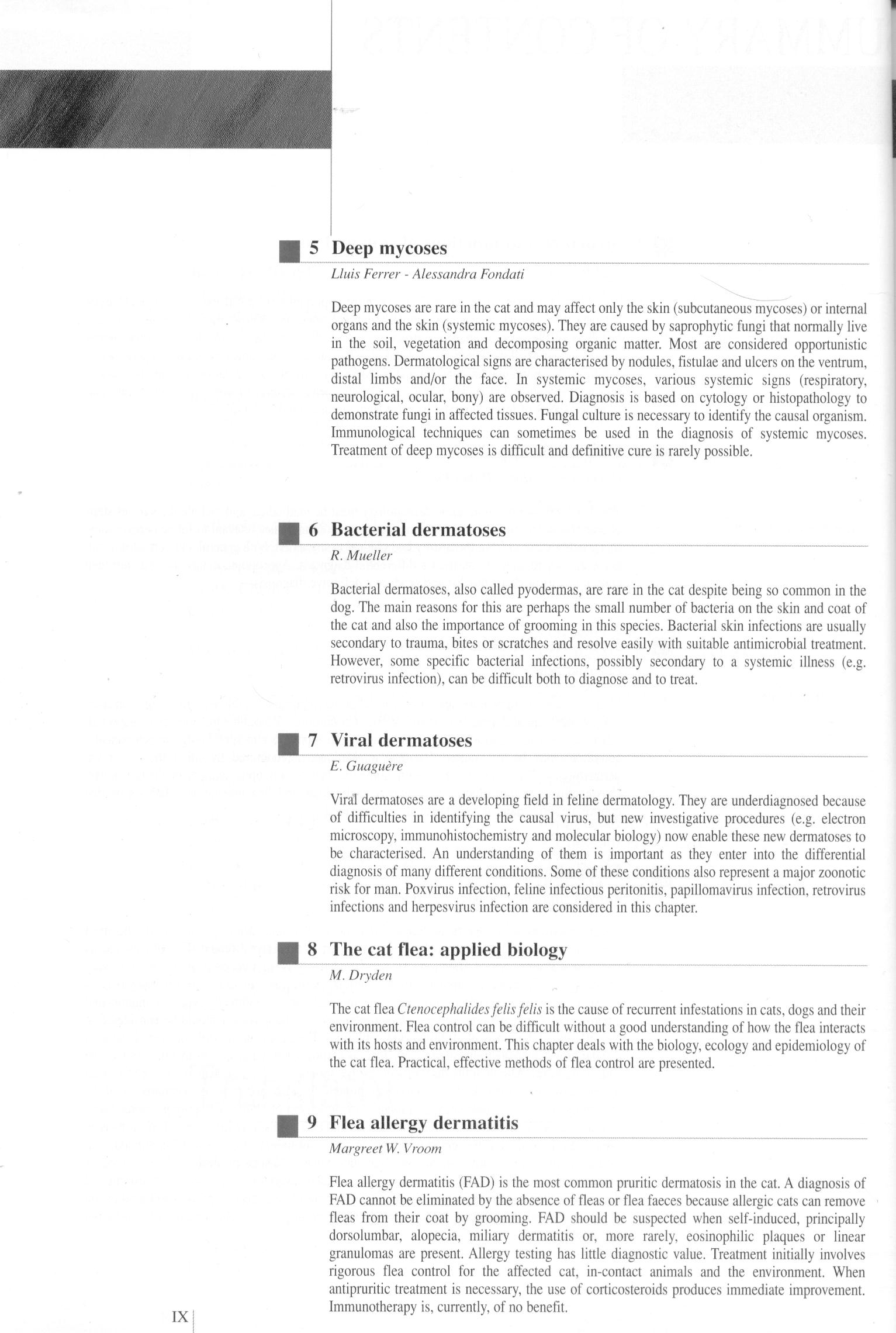3 (1497)

I 5 Deep mycoses
Lluis Ferrer - Alessandra Fondati
Deep mycoses are rare in the cat and may affect only the skin (subcutaneous mycoses) or intemal organs and the skin (systemie mycoses). They are caused by saprophytic fungi that normally live in the soil, vegetation and decomposing organie matter. Most are considered opportunistic pathogens. Dermatological signs are characterised by nodules, fistulae and uleers on the ventrum, distal limbs and/or the face. In systemie mycoses, various systemie signs (respiratory, neurological, ocular, bony) are observed. Diagnosis is based on cytology or histopathology to demonstrate fungi in affected tissues. Fungal culture is necessary to identify the causal organism. Immunological techniąues can sometimes be used in the diagnosis of systemie mycoses. Treatment of deep mycoses is difficult and definitive cure is rarely possible.
6 Bacterial dermatoses
R. Mueller
Bacterial dermatoses, also called pyodermas, are rare in the cat despite being so common in the dog. The main reasons for this are perhaps the smali number of bacteria on the skin and coat of the cat and also the importance of grooming in this species. Bacterial skin infections are usually secondary to trauma, bites or scratches and resolve easily with suitable antimicrobial treatment. However, some specific bacterial infections, possibly secondary to a systemie illness (e.g. retrovirus infection), can be difficult both to diagnose and to treat.
■ 7 Viral dermatoses
E. Guaguere
Viral dermatoses are a developing field in feline dermatology. They are underdiagnosed because of difficulties in identifying the causal virus, but new investigative procedures (e.g. electron microscopy, immunohistochemistry and molecular biology) now enable these new dermatoses to be characterised. An understanding of them is important as they enter into the differential diagnosis of many different conditions. Some of these conditions also represent a major zoonotic risk for man. Poxvirus infection, feline infectious peritonitis, papillomavirus infection, retrovirus infections and herpesvirus infection are considered in this chapter.
I 8 The cat flea: applied biology
M. Dryden
The cat flea Ctenocephalides felisfelis is the cause of recurrent infestations in cats, dogs and their environment. Flea control can be difficult without a good understanding of how the flea interacts with its hosts and environment. This chapter deals with the biology, ecology and epidemiology of the cat flea. Practical, effective methods of flea control are presented.
9 Flea allergy dermatitis
Margreet W. Vroom
Flea allergy dermatitis (FAD) is the most common pruritic dermatosis in the cat. A diagnosis of FAD cannot be eliminated by the absence of fleas or flea faeces because allergic cats can remove fleas from their coat by grooming. FAD should be suspected when self-induced, principally dorsolumbar, alopecia, miliary dermatitis or, morę rarely, eosinophilic plaąues or linear granulomas are present. Allergy testing has little diagnostic value. Treatment initially involves rigorous flea control for the affected cat, in-contact animals and the environment. When antipruritic treatment is necessary, the use of corticosteroids produces immediate improvement. Immunotherapy is, currently, of no benefit.
Wyszukiwarka
Podobne podstrony:
51 (177) Guide to Feline Dermatology L. Ferrer - A. FondatiDeep mycoses Deep mycoses are caused by t
INVESTMENT PROPOSALS OF MYKOLAYIV REGION INDUSTRY DEEP-WATER ESTUARY PORT IN DNIPRO LIMAN Short su
CONSTRUCTION OF DEEP-WATER BERTH Project initiator: The branch “Mykolaiy River Port” of JSSC
(Continued from page 11) element has some rolloff in the deep bass. to counter the boominess of clos
Deep Space 1 (1998), Dawn (2007) The spacecraft Deep Space 1 was launched October 24,1998 on top of
S5006679 Krato# Krzaka 4i Setecłed (Indsfróm the eettlement The deep change in the naturę of the cul
4 M. Sajewicz et al. rial obtained was then stored until analysis in the deep-freeze compartment of
“Vivid writing. Bonnie Leon immerses the reader in the time period, the setting, and deep into
By EDEARL REPP This globe deep in łhe earth, and łhe girl who had slept centuries was łhe only hope
208 M. D. PARAD KAR Telang’s motto had been ‘drink deep or taste not from the Piarian spring.’ He wa
calibre cover THE DEEP DARKSLEEP A great writer at the very top of his gamę PETER JAMES
więcej podobnych podstron